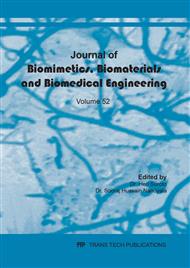[1]
M.L.L. Ivey, B.B.M. Gardener, N. Opian, S.A. Miller, Diversity of Ralstonia solanacearum Infecting Eggplant in the Philippines. Phytopathology, 97 (11) (2004) 1467-1475.
DOI: 10.1094/phyto-97-11-1467
Google Scholar
[2]
K. He, S.Y. Yang, H. Li, H. Wang, Z.L. Li, Effects of calcium carbonate on the survival of Ralstonia solanacearum in soil and control of tobacco bacterial wilt. Eur J Plant Pathol 140(4) (2014) 665-675.
DOI: 10.1007/s10658-014-0496-4
Google Scholar
[3]
K. Chen, R. A. Ali Khan, W. Cao, and M. Ling. 2020. Sustainable and Ecofriendly Approach of Managing Soil Born Bacterium Ralstonia solanacearum (Smith) Using Dried Powder of Conyza canadensis. Pathogens, 9 (327) (2020) 1-18.
DOI: 10.3390/pathogens9050327
Google Scholar
[4]
Y.A. Nion, K. Toyota, Recent trends in control methods for bacterial wilt diseases caused by Ralstonia solanacearum. Microbes environ. (2015) ME14144.
DOI: 10.1264/jsme2.me14144
Google Scholar
[5]
M.M. López, E.G Biosca, Potato bacterial wilt management: new prospects for an old problem,, in Bacterial wilt Disease and the Ralstonia solanacearum Species Complex, eds Allen C., Prior P., Hayward A. C. (St. Paul, MN: APS Press) (2005) 205–224.
DOI: 10.1007/s10658-005-5039-6
Google Scholar
[6]
B. Alvarez, M.M. Lopez, E.G. Biosca, Biocontrol of the major plant pathogen Ralstonia solanaceurum in irrigation water and host plants by Novel Waterborne Lytic Bacteriophages. Frontiers in Microbiology. 10 (2019) 2813.
DOI: 10.3389/fmicb.2019.02813
Google Scholar
[7]
S.R. Dhage, R. Pasricha, V. Ravi, Synthesis of fine particles at ZnO at 1000C. Materials Letters 59(7) (2005) 779-781.
DOI: 10.1016/j.matlet.2004.11.019
Google Scholar
[8]
J. Santhoshkumar, S.V., Kumar, S. Rajeshkumar, Synthesis of zinc oxide nanoparticles using plant leaf extract against urinary tract infection pathogen. Efficient Technol. 3(4) (2017) 459-465.
DOI: 10.1016/j.reffit.2017.05.001
Google Scholar
[9]
M.M. Sarong, R.F. Orge, P.J.G. Eugenio, J. J. Monserate, Utilization of rice husks into biochar and nanosilica: For clean energy, soil fertility and green nanotechnology. Int J Des Nat Ecodyn. 15(1) (2020) 97-102.
DOI: 10.18280/ijdne.150113
Google Scholar
[10]
A. Sirelkhatim, S. Mahmud, A. Seeni, N.H.M. Kaus, L.C. Ann, S.K.M. Bakhori, H. Hasan, D. Mohammad, Review on zinc oxide nanoparticles: antibacterial activity and toxicity mechanism. Nano-micro Lett. 7(3) (2015) 219-242.
DOI: 10.1007/s40820-015-0040-x
Google Scholar
[11]
R. Srinivasan, G.G. Selvam, S. Karthik, K. Mathivanan, R. Baskaran, M. Karthikeyan, M. Gopi, C. Govindasamy, In vitro antimicrobial activity of Caesalpinia sappan L. Asian Pacific Journal of Tropical Biomedicine. 2(1) (2012) S136-S139.
DOI: 10.1016/s2221-1691(12)60144-0
Google Scholar
[12]
K.S. Siddiqui, A. Rahman, A. Tajudding, A. Husen, Properties of zinc oxide nanoparticles and their activity against microbes. Nanoscale Res Lett. 13(141) (2018) 1-13.
DOI: 10.1186/s11671-018-2532-3
Google Scholar
[13]
O.A. Wintola, A.J. Afolayan, The antibacterial, phytochemicals and antioxidants evaluation of the root extracts of Hydnora africana thunb. used as antidysenteric in eastern cape province, south africa. BMC Complem. Altern. M. 15(1) (2015) 1-12.
DOI: 10.1186/s12906-015-0835-9
Google Scholar
[14]
Mujeeb, F., P. Bajpai and N. Pathak. 2014. Determination of Bioactive Components from Leaves of Aegle marmelos. BioMed Res. Inter. Hindawi Publishing Corporation. Article ID 497606.
DOI: 10.1155/2014/497606
Google Scholar
[15]
J. Santhoshkumar, S.V., Kumar, S. Rajeshkumar, Synthesis of zinc oxide nanoparticles using plant leaf extract against urinary tract infection pathogen. Efficient Technol. 3(4) (2017) 459-465.
DOI: 10.1016/j.reffit.2017.05.001
Google Scholar
[16]
J.R. Salazar, J. J. Monserate, Electrospun Polylactic acid (PLA)-Nanosilica (nSiO2)-Cellulose Acetate Nanofiber Composite: A potential biomaterial bone tissue scaffold. Asia Life Sciences 27(2) (2018) 481-495.
Google Scholar
[17]
H. Kaur, M. H. Amini, P.K., Prabhakar, A. Singh, A. Suttee, Phytochemical Screening and Antimicrobial Activity of Caesalpinia sappan L. Leaves. Int. J. Pharmacogn. Phytochem. Res. 8(6) (2016) 1040-1045.
Google Scholar
[18]
S. Saravanakumar, J. Helan Chandra, Screening of antimicrobial activity and phytochemical analysis of Caesalpinia sappan L. J Chem Pharm., 5(2) (2013) 171-175.
Google Scholar
[19]
O. Yamamoto, Influence of particle size on the antibacterial activity of zinc oxide. Int. J. Inorg. Mater., 3(7) (2001) 643–646.
Google Scholar
[20]
A. Azam, A. S. Ahmed, M. Oves, M. S. Khan, S. S. Habib, A. Memic, Antimicrobial activity of metal oxide nanoparticles against Gram-positive and Gram-negative bacteria: a comparative study. Int J Nanomedicine. 7 (2012) 6003-6009.
DOI: 10.2147/ijn.s35347
Google Scholar
[21]
S. Fakhari, M. Jamzad, H. Kabiri Fard, Green synthesis of zinc oxide nanoparticles: a comparison. Green Chem. Lett. Rev., 12(1) (2019) 19-24.
DOI: 10.1080/17518253.2018.1547925
Google Scholar


